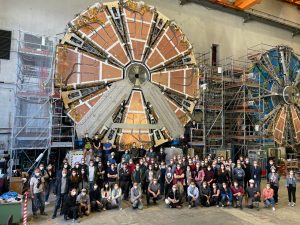
An important milestone for the ATLAS upgrade project has been achieved: it has been completed the first wheel of the forward muon spectrometer required to cope the increase in luminosity foreseen in the upcoming phases of the LHC data taking.
On Friday 28 May the last of the sixteen wedges that make up the first New Small Wheel (NSW) has been installed and it is now ready for the installation in the ATLAS cavern in July.
On the first days of July, the 100 tonnes wheel will be transported in the Atlas experimental hall and the next week will be lowered 80 metres underground at the LHC level. The NSW consists in a set of new precision tracking detectors based on the Micromegas technology and new trigger detectors Small Strip Thin Gap Chambers. The production of these detectors involves 9 countries worldwide. The Italian National Institute for Nuclear Physics was responsible for the construction of a quarter of the Micromegas chambers and for bringing into operation the detectors of the other construction sites. These are gaseous detector with planar geometry, quadri-gap, trapezoidal shaped with an area of 2 m2. This is the first time that this kind of technology is applied to realize detectors of such dimensions, representing a great challenge for the international scientific community. An assembly and commissioning system of these components has been developed at the Frascati National Laboratory (LNF).
Under the supervision of the NSW project coordinator, Mario Antonelli, formerly responsible for the construction of Micromegas chamber at LNF, it is ongoing the completion of the second wheel, NSW-C, on which 3 of the 16 final sectors have already been installed.
The Atlas experiment on LNF web page
News “The MicroMegas detectors ready for ATLAS”
 INFN-LNF Laboratori Nazionali di Frascati
INFN-LNF Laboratori Nazionali di Frascati